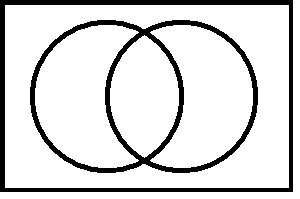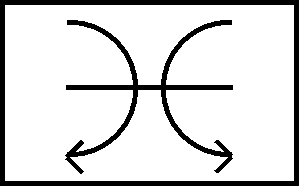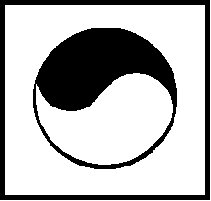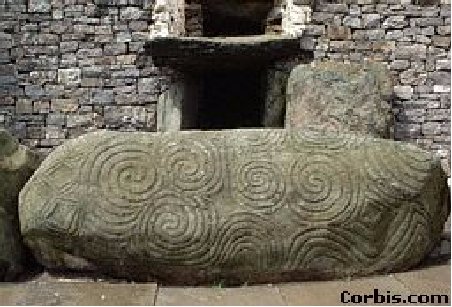EPILOGUE
CHRISTOGENESIS
To live the cosmic life is to live dominated by the consciousness that one is an atom in the body of the mystical and cosmic Christ.
Teilhard de Chardin (1)
The Great Fish
Much of the symbolism to emerge at the beginning of the Christian era had its origin in the geometric motif known as the vesica piscis. Constructed from two identical, intersecting circles whose centers are on each other’s circumferences, the “fish” in the center served as the spawning ground for some of the most familiar symbolism of Piscean Age Christianity.

Figure E-1
The Vesica Piscis
The vesica, or “vessel of the fish,” is symbolic of the Incarnation: Christ is the fish—the intersection wherein the human and the divine merge. Strachan explains:
Christ is the “Great Fish” in the sea, having descended into that sea to redeem floundering humanity. (2)
Another name for the vesica is mandorla, Italian for almond.
Plate VIII-3, (in the last chapter,) illustrates how Medieval and
Renaissance artists used the shape as an artistic device to portray Christ
in his majestic or glorified appearances. Another example is in the icon of
Plate V-1, in which Jesus is stepping out of the vesica and into
Hell.
The Reconciliation of Opposites
The graphic sign for Pisces expresses the idea of opposition, with the two halves of a circle (a whole) separated, held apart, and understood to be moving in opposite directions—one clockwise and the other counterclockwise. (Figure E-2)

Figure E-2
The Sign of Pisces
As the vesica piscis is the geometric reconciliation of the opposition of Pisces, so in the Incarnation the duality inherent to human nature is resolved. In Paul’s words: “God was in Christ reconciling the world to himself."(3)
Another geometric resolution of the opposition between spirit and nature is expressed in the familiar yin/yang symbol of Taoism. Here heaven and earth, and all other dualities, are recognized as the “illusion” by which the manifest world is created, and how, in a rhythmically-balanced interchange of opposites, the “illusion” is maintained. Moreover, this Taoistic notion of the illusive and interchanging idiosyncrasy of energy and matter approximates the determinations of quantum physicists. (Figure E-3)

Figure E-3
The Yin/Yang Interchange of Opposites
Some early Christian symbolists, who may have been Pythagorean geometricians as well, saw the vesica as the womb of the equilateral triangle and therefore symbolic of the Holy Trinity. The Trinity, and the number three as its numeric equivalent, is another way of understanding how duality is reconciled. Figure E-4 details how a perfect triangle is derived by connecting points “a” and “b”--the centers of the two circles—and then points “a” and “b” to “c.” When “a” and “b” are also connected to “d,” the result is a perfect diamond.
Figure E-4
The Vesica Derivation of the Equilateral Triangle,
the Diamond, and the Gothic Arch.
The same vesica is the
geometric source of the gothic arch, with the arc of “a” to “b,” and then
“b” to “c” basic to the architecture of the great Medieval cathedrals.
Moreover, this same arch will be recognized as the design source of the
miter worn by bishops--the episkopos--with this Greek word containing
the same root as piscis. Taking the symbolism a step further, the
“episkopos” carried a shepherd’s crook as a reminder of his role to bring
the Arien sheep into the Piscean fold.
Humanity’s Collective Nativity
In the changing symbolism of the subsequent ages, the caught fish of Pisces are contained in the water pitcher of Aquarius, to there await the time--the kairos--of their release into the sea of humanity. Close to this idea is Teilhard’s conceptualization of Christogenesis--the birth of the whole Christ--in which the Incarnation is extended to the collective, evolutionary birth of humanity as a whole. Birth, however, implies a mother--in this case, not a human mother but a divine mother of humanity--one who can give birth to the divine potential of all her children, and who can encourage and empower them to become the co-creative sons and daughters of God. But it has been a very long time since some of her children have “called home.” This troubled Jung immensely, knowing as he did that alienation from the mother has psychic repercussions.
Robert Faircy, a Jesuit professor of spirituality, compares the thinking of Teilhard and Jung, and discusses their mutual concern around the devaluation of the feminine.(4) Both, he explains, understand the feminine as the missing “fourth”: the feminine as matter, nature, and mother. Teilhard knows her intimately as “the Blessed Virgin Mary”; Jung as the Archetypal Feminine who, as a Jewish maiden named Mary, becomes the mother of the divine/human, God/man, and who, as instructed by the angel, names her son Jesus.
It was gratifying to both Teilhard and Jung to live long enough to celebrate Mary’s “official,” (i.e., papal,) elevation to the heavens. Fr. Faircy writes:
What Teilhard affirms at the level of faith vision and of theology, Carl Jung verifies at the level of the psychology of religious symbols. Both are concerned with how the Christian today understands his faith, with how he sees, with the symbols that represent and that concretize his faith vision. And both, each in his own way, affirm the mother of God as having her place in that faith vision--a place with God, with the risen Christ, in heaven bodily. . . . [to fulfill] the symbolic functions of representing all femininity, all maternity, . . . .
Fr. Faircy then recalls that with
Thomas Merton, they see Mary as “Hagia Sophia,” the wisdom of God, “the feminine principle in the world. . . the inexhaustible source of creative realizations of the Father’s glory.” The Blessed Virgin Mary, Merton writes, “can be said to be a personal manifestation of Sophia, Who in God is Ousia [the Divine Essence] rather than Person.” Mary’s consent at the annunciation “opens the door of created nature, of time, of history, to the Word of God. God enters into his creation.” And, we might say, creation begins to enter into God.(5)
Does it not make sense
that if there is to be a collective Incarnation--a Christogenesis--that
preliminary to this happening all of God’s children need to be reconciled to
their mother, to the feminine principle, to the “Mother of All,” and by
whatever name each chooses to call her? And that then through her they be
reconciled to one another? Is not this the way of many families? That for
the sake of the mother the children stay in touch, and if they have a
grievance with one another, then, for her sake, they “get over it.”
Teilhard’s Legacy
Central to Teilhard’s thinking is Jesus’ role as the “central axial line” along which evolution is moving towards “the final reconciliation of all things in Christ." This passage is, in fact, the theme of the last entry in Teilhard’s journal, made three days before his death on Easter Sunday, 1955. In a notational formula he brings together his life, his religion, and his science: “Noogenesis=Christogenesis (=Paul).” From the birth of mind to the birth of the Whole Christ is how Teilhard interprets Paul’s “En pasi panta Theos”--“that God may be all in all."(6)
Teilhard envisions the final stage of the evolution of consciousness as from mind (noo) to Spirit (Christo), a process he understands Paul to have begun on the road to Damascus. And perhaps Teilhard’s inside track into the mind of Paul is due to Teilhard’s own mental-to-spiritual transformation. In any event, Thomas Berry offers the opinion that
From the
viewpoint of our present understanding of the universe it could be said that
Teilhard is the most significant Christian theologian since Saint Paul.(7)
Teilhard’s Dangerous Prayer
As Paul created the bridge over which first century Christianity could be extended from a Jewish sect to a universal religion, so Teilhard’s legacy to Christianity is an evolutionary and cosmic perspective. In his Easter passage from the realm of the temporal to the eternal, he left a renewed and revitalized vision for the Church he loved. But for the individual undergoing the Christing process, he left a more personal and fervent testimony in the form of a prayer, one he prefaced with the words: “I firmly believe the Christianity of tomorrow will find its increasingly clear portrayal” in the following:
Lord, lock me up
in the deepest depths of your heart;
and then, holding me there,
burn me,
purify me,
set me on fire,
and lift me aloft,
until I become utterly
what you would have me be
through the cleansing death of self.(8)
Teilhard’s prayer has been called “the dangerous prayer.” To make its words one’s own and say them from the heart is to surrender to the higher will of God for one’s life, and also to assent to whatever such a transformation-by-fire may require. In Jung’s words, to follow where this leads is to be transformed by one’s “higher destiny.”
To the visionary eyes of both Teilhard and Jung, standing as they did at the crossroads of one age’s ending and another’s beginning, the signs appeared to be pointing to a time--a kairos—pregnant with the expectation of humanity’s collective Nativity, when, as Jung’s writes:
[O]nce
again the Holy Ghost descends, this time to bring about a “Christification
of many.” For the individual this means . . . . not an “imitation of
Christ” but its exact opposite: an assimilation of the Christ-image to his
[or her] own self . . . .(9)
The Road Ahead
Having entered its third millennium, what are the choices Christianity now faces?
Over the course of the first millennium, Christianity was a somewhat homogenous mixture of its Eastern, Western, and Coptic branches, together with the splintering heresies of its beginning centuries. But by the second millennium a split between the spiritual citadels of Constantinople and Rome was inevitable. In the West, Rome had strengthened its role as intermediary between earth and heaven, a position it maintained until the mid-millennium Reformation.
Again, at the beginning of the third millennium, another regrouping appears inevitable, one that quite possibly could offer “a third way,” a synthesis of opposites. If so, what are the signs? And where do they point?
Within both Catholicism and Protestantism are those determined to hold fast to their traditional positions. At the same time, there are within these two main streams of the Western Church those who are more in agreement with one another than with the conservative branches of their respective parent churches. Within Catholicism the emphasis tends towards ritual, tradition, and an hierarchical structure of authority: while within fundamental, evangelical Protestantism, emphasis is placed on the authority of the Bible, as well as on personal religious experience, and a well-defined position as to what is meant by “salvation.”
Among Catholics there are those who value
much in their tradition, but who no longer are comfortable under strict
hierarchical authority. Similarly, there are Protestants who value the
attributes of their faith, but who are uncomfortable with an authoritarian
attitude towards the scriptures. Nor is it just a matter of being
discontent with what is. There is also, among both Catholics and
Protestants alike, a sense that something is missing, a failure to find
fulfillment for their spiritual hunger. For some, religion feels more like
a monologue than a dialogue. For some, church feels more like being an
audience than a participant in the drama of one’s own, ongoing spiritual
transformation. While meaningful changes are undoubtedly underway, many
have simply left their pews to search out other ways of facilitating their
own and others’ psychological/spiritual wholeness.
The Third Way
As previously noted, both Jung and Teilhard were outspoken in pointing out that was what missing from Christianity was recognition of the feminine principle as being on equal ground with the masculine. Faircy also echoes this:
Only to the extent that the feminine is restored to its primacy in Christianity will Christianity find itself in good health. And only to the point that the suppression of the feminine is corrected will our Western culture recover from its many illnesses.(10)
Everywhere the rise of the feminine for recognition and parity is evident. And because the imbalance is centuries’ old, the demand for restoration is coming from the deepest levels of the collective psyche. In other words, one way or another balance will be restored, either through human understanding and cooperation, or through nature herself. This, of course, is another way of saying “at the hands of the goddess” in her destructive or de-structuring role as Kali.
By definition, a third way is the way by which opposites are united. The wisdom of the Tao speaks of “the Undivided, the Divided, and the Reunited.” A very ancient symbol is surprisingly appropriate for the possibilities open to a third millennium spirituality that is inclusive of the feminine. As might be expected, it is goddess-related--the triple spiral of the ancient “Triple Goddess” of Celtic spirituality.
Figure E-5
The Triple Spiral of the Triple Goddess
The motif of Figure E-5 is a replica of the triple spiral found in the main chamber of the megalithic tomb-sanctuary at Newgrange, Ireland. It is dated around 3000 BC, and part of the Stone Age Irish “grave-passage” culture. A similar triple spiral also appears on the Newgrange entrance stone.

Plate E-1
The Entrance Stone at Newgrange, Ireland
The triple role of the
ancient goddess was to preside over birth, life and death. As triune as
nature’s birth/death/rebirth cycle, she was maiden, bride and crone. When
Christianized the ancient Celtic goddess become the new Brigid, the “saint”
of hearth and home in whose name the fires were re-lighted each year on her
February first saint’s day.
The Celtic Renaissance
Midst the megalithic remnants of ancient goddess cultures, the Celts were captive to the presence of the past (the morphogenic resonance) in the land they now occupied. Moreover, there were the everywhere reminders of the ancient ones’ beliefs that death is a passage to another world. The stones bearing this message were massive; the symbolic language of the carvings laboriously intricate; the underground burial sites comparable in calculated human labor to the great pyramids, and thought to be as much as five hundred years older. Through these monuments to the mother-goddess of old, she continued to teach that all of existence is cyclic in nature, and that there is a direct continuity between the material world and the other-world.(11)
The pre-Christian tradition of the Druids of Wales also recognized the unseen world as interpenetrating and effecting the visible world.(12) Considering the credibility quantum physics is lending to similar ideas, is it any wonder that Celtic spirituality is experiencing a renaissance?
In any event, the attraction of Celtic spirituality is part of a larger attraction to certain ancient traditions containing the elements missing from the life and culture of our times. The Celtic renewal is parallel to the long-overdue appreciation being afforded Native American spirituality, with the appeal of both to religiously affiliated and unaffiliated seekers alike.
Moreover, the roots of Celtic spirituality are not limited to the “Isles of the North.” They reach even further back in time to the Rhineland where, as Matthew Fox informs, the spiritual lineage of Hildegard of Bingen, Meister Eckhart and other “high mystics” of that area, can be traced to Celtic origins, and whose spirituality has both ecumenical and global appeal.(13) As Hildegard lived through most of the twelfth century, two years after her death Francis of Assisi would be born to carry forward the imprint Celtic spirituality in his nature mysticism, with his personal lineage traced to his Celtic-French mother, and the wandering troubadours of her origins.
Akin to the renewal of interest in Celtic spirituality is an attraction to monastic life in general, and the possibilities of living a non-monastic life according to a spiritual Rule of Life. An example is my own Franciscan order, which is one of several “third” orders with Catholic, Anglican and Ecumenical branches. Some Benedictine orders as well are ecumenically inclusive, including the one with whom I have received training in spiritual direction, and whose abbot is a Jungian.
Shamanism is another “third way” approach to spirituality. It is the one my husband Bob has been pursuing for a number of years, including the Celtic shamanism of his Northern European spiritual heritage.
With the hunger for a more meaningful
spiritual life everywhere apparent, there are still very few churches who
are openly encouraging their members to discover the new-old pathways to
greater psychological and spiritual wholeness. When the two--the
psychological and the spiritual—do come together, whether within or without
the walls of a church, “the third way” is discovered: the way of the
feminine, of relationship, of connection to life, to the earth, to others.
Isolation, separation, despair is overcome. God--as Mother, Father, Sister,
Brother, Son, Daughter, Friend--lives in the compassion of a people who care
for and support one another, and who, having heard the call of the Christ
“to come up higher,” are doing just that.
Illustrations:
Plates:
E-1 - Megalithic Entrance Stone at Newgrange, Ireland, Photo credit:
Corbis
Figures (by author)
E-1 - The Vesica Piscis
E-2 - The Graphic Sign for Pisces
E-3 - The Yin/Yang Interchange of Opposites
E-4 - The Vesica Derivation of Equilateral Triangle, Diamond, and
Gothic Arch
E-5 - The Triple Spiral of the Triple Goddess
Notes:
1. From Cosmic Life, by Teilhard de
Chardin. Quoted by Ursala King in Spirit of Fire, Orbis Books, NY,
1996, p55.
2. Gordon Strachan, Christ and Cosmos, Labarum Publications,
Scotland, 1985, p 99
3. II Corinthians 5:19
4. Robert Faircy, SJ, The Lord’s Dealing, The Primacy of the
Feminine in Christian Spirituality, Paulist Press, NY, 1988, pp 65-66,
with the Merton quotes from The Collected Poems of Thomas Merton, NY,
New Directions, 1977, pp 369-370
5. Faircy, op cit, p 98
6. Teilhard de Chardin, The Future of Man, Harper & Row, 1964, p 309,
(French edition, 1959)
7. Thomas Berry (source lost, hope to recover. ae)
8. Teilhard de Chardin, Hymn of the Universe, Harper & Row,
Perennial Library, NY, 1965, p 26
9. Jung/Edinger, op cit, Mysterum Coniunctionis CW 14, par.492,
quoted by Edinger, Christian Archetype, p 18
10. Faircy, op cit, back cover.
11. Nigel Pennick, The Sacred World of the Celts, Inner Traditions
International, Rochester, VT, 1997, pp 68 & 138
12. Ibid
13. Matthew Fox, Illuminations of Hildegard of Bingen, Bear &
Company, Santa Fe, NM, 1985, see pp 7 & 16
Return to Higher Ground Home
Return to Murraycreek Homepage